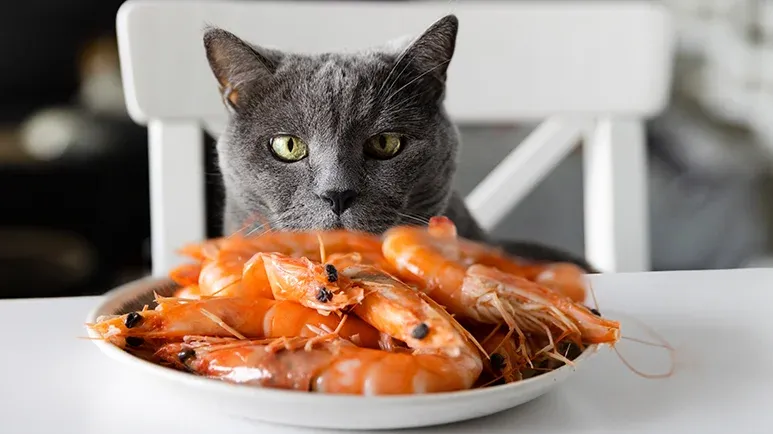Is This Treat a Purr-fect Snack or a No-Go?
Curious if your cat can share a bite of this popular seafood? Discover whether this tempting treat is a healthy indulgence or a slip-up for your feline friend.

STORY AT-A-GLANCE
- Shrimp can be a nutritious, low-calorie treat for cats, offering lean protein and beneficial nutrients like omega-3s, vitamin B12, and selenium — but only in moderation
- While shrimp supports healthy muscles, skin, and coat, it lacks essential feline nutrients such as vitamin A, vitamin D, and niacin, so it should never replace a balanced cat diet
- Raw, seasoned, or processed shrimp can pose serious health risks, including bacterial infection, salt toxicity, and digestive irritation — only plain, fully cooked shrimp is safe
- Always remove shrimp shells, tails, and veins before feeding; these parts can cause choking, stomach injury, infection, or blockages in your cat's digestive tract
- For most healthy cats, a small shrimp treat once or twice a week is plenty — think of it as an occasional indulgence, not a dietary staple
If you have ever sat down to enjoy a plate of shrimp and caught your cat staring with those big, pleading eyes, you have probably wondered, "Can I give them a bite?"
After all, cats and seafood just seem to go together. We picture them pawing at fish markets or sneaking bites of salmon. But when it comes to shrimp, is this tasty seafood a safe treat — or one to keep off your cat's plate?
Let's dive deep into what science and veterinarians say about shrimp for cats. You will learn how this seafood stacks up nutritionally, what risks to watch out for, and how to prepare it safely if you decide to share.
The Meat of the Matter — What Cats Really Need
Before you hand over that shrimp, it helps to understand how cats are wired to eat. Cats are obligate carnivores, meaning they need to get most of their nutrients from meat. Unlike humans or even dogs, cats cannot thrive on plant-based diets or make certain key nutrients on their own. A cat's body depends on nutrients that are found almost exclusively in animal tissue, such as:
- Taurine, an amino acid crucial for heart health, vision, and reproduction.
- Vitamin A, important for eyesight and immune function.
- Vitamin B12, essential for nerve and digestive health.
- Calcium and phosphorus, which work together to build strong bones and teeth.
Because of these needs, a cat's primary diet should always come from high-quality, balanced cat food that is designed specifically for feline nutrition. Treats like shrimp can complement this diet but never replace it.1,2
Shrimp — A Closer Look at Nutrition
Shrimp is small but mighty when it comes to nutrients. It is packed with lean protein, is naturally low in calories, and contains a handful of essential vitamins and minerals that can benefit cats in small amounts. Here is what shrimp offers:
- High-quality protein — Builds and repairs tissues, supports a healthy immune system, and gives your cat energy to pounce and play.
- Omega-3 fatty acids — Support heart health, reduce inflammation, and promote a shiny coat and healthy skin.
- Vitamin B12 — Helps with energy production and supports the nervous system.
- Phosphorus — Works with calcium to keep bones strong.
- Selenium — Acts as an antioxidant, protecting cells from damage.
- Choline — Supports brain and liver health.
Together, these nutrients make shrimp a nutritious, low-fat snack option for cats. However, keep in mind that shrimp is not a complete meal, as it is missing key nutrients like vitamins A and D that cats need daily.3,4 So, think of shrimp as a tasty treat, not the main course.
Why Shrimp Can Be Good for Cats
When offered occasionally and prepared properly, shrimp can give your cat a healthy little boost. Protein is the foundation of your cat's diet, and shrimp delivers plenty of it without unnecessary fat or fillers. This helps maintain lean muscle mass, especially important for active cats and growing kittens.
For cats that may need to control their calories, shrimp is a great low-calorie treat. A single shrimp has only about 7 calories, which makes it perfect for rewarding your feline friend without overfeeding.
And thanks to those omega-3 fatty acids, shrimp may help keep your cat's fur soft and shiny. Omega-3s also support joint health and can help reduce mild inflammation, making them beneficial for older cats with arthritis.
Nutrients like vitamin B12 and choline in shrimp support nerve function, heart rhythm, and brain activity, keeping your cat alert, active, and content.
Finally, cats can get bored eating the same thing every day. Offering an occasional shrimp snack can spice up their menu and stimulate their appetite.
Risks of Feeding Shrimp
While shrimp can be safe, there are definitely some risks to keep in mind. Just like humans, cats can have allergies or sensitivities to shellfish. Signs of an allergic reaction may include:5
- Itchy skin or face rubbing
- Swelling or hives
- Vomiting or diarrhea
- Excessive licking or grooming
- Lethargy or hiding behavior
If your cat shows any of these symptoms after eating shrimp, stop feeding it immediately and contact your veterinarian.
Shrimp shells, tails, and heads are tough and can cause choking or internal damage. Always remove the shell, tail, head, and vein before feeding shrimp to your cat.6 In addition, raw, undercooked, or poorly cleaned shrimp can harbor harmful bacteria such as Salmonella or E. coli. Cats are just as vulnerable to foodborne illness as humans are. Always cook shrimp thoroughly before serving.
Lastly, many shrimp products — especially frozen, pre-cooked, or restaurant varieties — are seasoned, salted, or treated with preservatives. These additives can be harmful to cats.
Remember, always stick with plain, unseasoned shrimp. Even a healthy treat can cause trouble if you give too much. Feeding shrimp too often can upset your cat's nutritional balance or lead to digestive issues like diarrhea. Treats, including shrimp, should make up no more than 10% of your cat's daily calories.7
How to Prepare Shrimp the Safe Way
If you have decided shrimp is on the menu, preparation matters as much as portion size. Follow these steps:
- Pick fresh or frozen shrimp that is free of additives, salt, or preservatives. Avoid pre-cooked or flavored shrimp, since those are often seasoned for human palates.
- Remove the dangerous parts. Peel off the shell, cut off the head and tail, and remove the vein that runs along the back. These parts are indigestible or can harbor bacteria and can cause choking or stomach irritation.
- Cook it properly by boiling or steaming, which is the safest way to cook shrimp for cats. Cook until the shrimp turns pink and firm — that means it is fully cooked. Never fry, grill, or sauté shrimp in oil, butter, or spices.
- Cool and cut. Let the shrimp cool to room temperature, then cut it into bite-sized pieces to make it easy for your cat to chew and swallow.
- Keep it plain — no seasonings, no sauces, and no dips.
- Serve it slowly. Offer just a small piece at first and see how your cat reacts. If they tolerate it well — no vomiting, scratching, or stomach upset — you can occasionally make it a part of their treat rotation.
How Much Shrimp Is 'Just Right'?
For most cats, shrimp should be an occasional treat — once or twice a week is plenty. Use this as a general guide:
- Small cats (under 10 pounds) — Give 1/2 shrimp per serving
- Large cats (over 12 pounds) — Give 1 full shrimp per serving
Kittens or cats with health issues (like kidney disease or allergies) should have even less — and only after your veterinarian gives the green light.
Other Healthy Protein Alternatives to Shrimp
If you want to offer your cat variety but are not sure about shrimp, there are plenty of other tasty, safe options:
- Chicken or turkey — High in lean protein and gentle on the stomach.
- Beef and lamb — Provides iron and other essential minerals.
- Salmon and sardines — Great sources of omega-3s; just ensure they are cooked and free of seasoning.
- Liver (occasionally) — Packed with vitamins but best given in moderation due to high vitamin A content.
Each of these offers valuable nutrients similar to shrimp without the potential shellfish risks.8,9
The Final Verdict
So, is shrimp a safe snack for your cat? Yes, but only if it is cooked, plain, and served in moderation. When served safely and occasionally, shrimp can absolutely be a purr-fect snack for your cat — tasty, nutritious, and satisfying. But remember, moderation and preparation are everything.
A cat's health depends on a balanced diet built around high-quality cat food. Treats like shrimp are just that — treats. So next time those curious eyes peek up at your dinner plate, you can share a bite, wisely, safely, and lovingly.










